After a few football-free summer months, the 2015/2016 season is now up and running for most European clubs. Fans across the continent will make weekly pilgrimages to support their teams until next May ahead of Euro 2016, which begins in June. With all that football to savour, here are ten of the best football stadium experiences in Europe.
1) Millerntor-Stadion, Hamburg, Germany
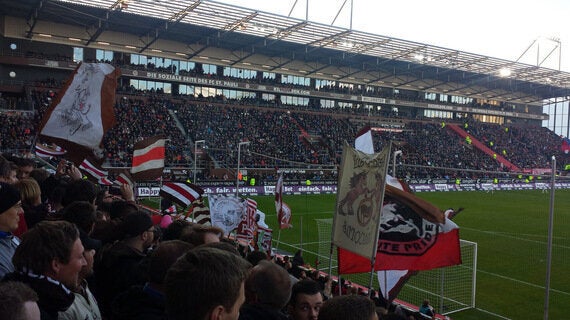
(Source: Steve Watkins, Flickr)
Year opened: 1961
Capacity: 29,546
Tenants: FC St. Pauli
Based near Hamburg's red-light district the Reeperbahn, Millerntor-Stadion is home to FC St. Pauli, one of the most intriguing clubs in world football. With an ardent left-wing philosophy and punk aura, the club transcends mere football fandom - and this helps generate a raucous, anarchic atmosphere on matchday. St. Pauli boast the largest number of female fans in German football and have spawned fanclubs from all over the world, with people falling in love with the club as much for its identity and sense of belonging as its football. Despite currently languishing in the lower reaches of the German second division amid decades of unremarkable on-field success, St. Pauli have more season ticket holders than many Bundesliga teams.
2) Signal Iduna Park, Dortmund, Germany
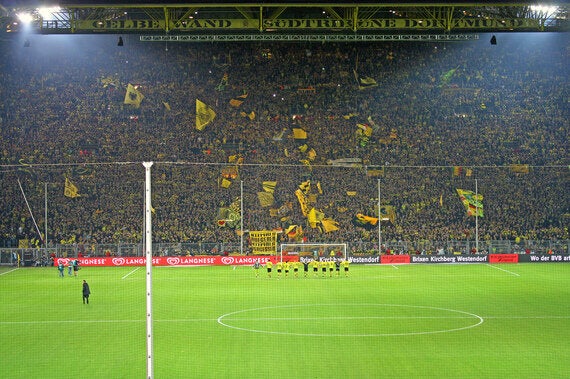
(Source: Andreas, Flickr)
Year opened: 1974
Capacity: 81,359
Tenants: Borussia Dortmund
Borussia Dortmund's Westfalenstadion (officially named Signal Iduna Park under a sponsorship arrangement) is considered the poster child for continental safe standing amongst British football fan groups. Unlike most of the rest of Europe, German clubs resisted the move to all-seater stadia, and in recent years many of them have upgraded their terraces with "rail seats" - metal seats that can be flipped up and locked in place, providing space to stand behind a waist-high rail. An estimated 1,000 Brits travel to Dortmund every fortnight during the football season to experience the 25,000-capacity "Yellow Wall" south stand terrace which utilises this form of free-standing. New manager Thomas Tuchel has inherited an exciting team, and visitors to the stadium can expect to enjoy some electric counter-attacking football spearheaded by German superstar Marco Reus.
3) San Siro, Milan, Italy
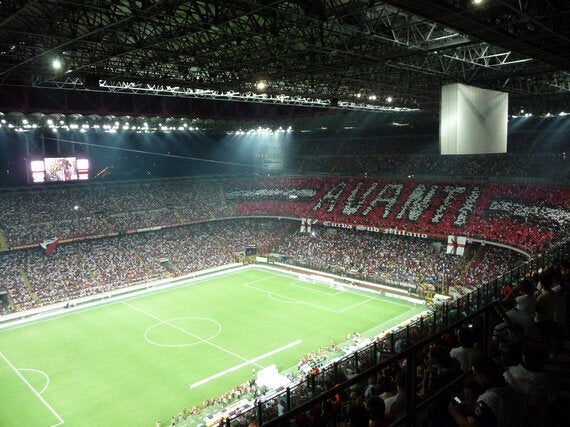
(Source: Jon Seb Barber, Flickr)
Year opened: 1926
Capacity: 80,018
Tenants: AC Milan, Internazionale
Nicknamed Milan's "other cathedral", Stadio Giuseppe Meazza, commonly known as the San Siro, is home to Milan giants AC and Inter. With its distinctive red iron girders and huge rectangular roof, the San Siro is a certified legendary football stadium and will host this season's UEFA Champions League final. Twice a season the stadium stages the passionate Derby della Madonnina, featuring the city's aforementioned rivals, and the ground comes alive with a mix of flags, flares, fireworks and huge banners. At the highest points of the third tier, the stadium's stunning vantage points also offer views of the city. The San Siro is a Mecca for football fans and remains one of the must-see grounds in Europe.
4) Camp Nou, Barcelona, Spain

(Source: David, Flickr)
Year opened: 1957
Capacity: 99,354
Tenants: Barcelona
Built between 1954 and 1957, Barcelona's Camp Nou is the biggest football stadium in Europe and the second largest football stadium in the world after the 150,000 capacity Rungnado May Day Stadium in, err, North Korea. Europe's most popular football weekend destination, visitors can undertake an impressive stadium tour and learn about Barcelona's history. Holidaymakers to the city can expect to enjoy fizzing nightlife, fine modern dining and historical sightseeing in addition to the world's most revered team - complete with Lionel Messi, the world's best player.
5) Craven Cottage, London, UK

(Source: slimmer_jimmer, Flickr)
Year opened: 1896
Capacity: 25,700
Tenants: Fulham
With its wooden seats and pillars, Fulham's Craven Cottage is a Victorian football ground that sits on the banks of the River Thames. Experiencing a match there feels like a throwback to a time where football was exclusively played at 3pm on a Saturday afternoon, well away from the glare of television cameras and electronic advertising hoardings. Nestled between the ground's Putney End and Johnny Haynes Stand is an 18th century cottage, which feels as far removed from modern, corporate-friendly £100-a-ticket stadiums as it is possible to get. With new stadiums popping up around the country each year, Intimate football grounds like this are something of a dying breed in English football, though there are other old-fashioned football pleasures to be had in London, including Queens Park Rangers' Loftus Road and Crystal Palace's Selhurst Park.
6) San Mamés, Bilbao, Spain
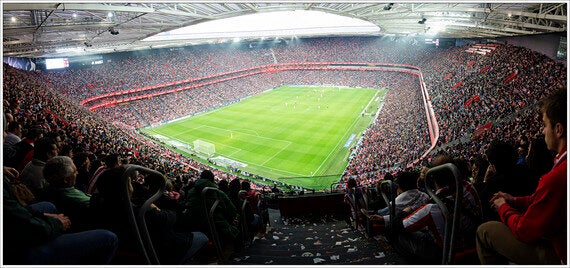
(Source: Martin P. Szymczak, Flickr)
Year opened: 2013
Capacity: 53,289
Tenants: Athletic Bilbao
San Mamés is the newest stadium on this list, and much like Athletic Bilbao's 100-year-old former home (also named San Mamés) it is a compact, English-style fortress, with a cracking atmosphere of passionate Bilbao fans. Athletic are a unique club and its team is comprised exclusively of players from the Basque Country. In an age where multi-million pound transfers are de rigueur for top clubs in the big leagues - especially Spain's La Liga - Athletic's determination to uphold traditions like these draw admiration from football fans far and beyond the region.
7) Estadio Municipal, Braga, Portugal
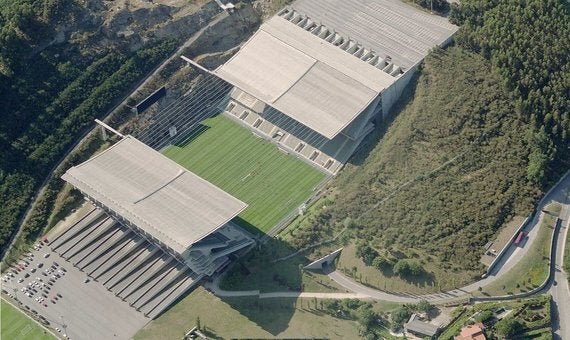
(Source: eager, Flickr)
Year opened: 2003
Capacity: 30,286
Tenants: Braga
Built in 2003, SC Braga's Estadio Municipal is carved into the face of the Monte Castro quarry, and a simply beautiful piece of architecture. Unusually for a football stadium, Estadio Municipal consists of only two stands, which run along both sides of the pitch. Behind the goal at one end are the rock walls of the quarry and at the other is an open view of the sprawling city of Braga. Each stand is covered with a canopy-style roof, and both are connected to each other across the pitch by dozens of steel strings, a design inspired by ancient South American Inca bridges.
8) Igraliste Batarija, Trogir, Croatia
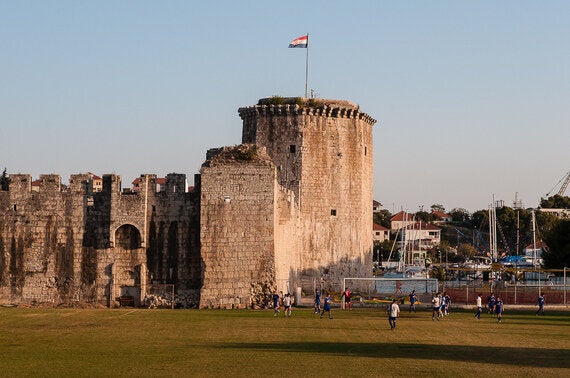
(Source: Hervé, Flickr)
Year opened: 1912
Capacity: 1,021
Tenants: HNK Trogir
By far the smallest ground on the list, Igraliste Batarija is located between two protected 15th century monuments: Kamerlengo Castle, built by the Venetians, and the tower of St Marco - a Renaissance-style fortress. Tenants HNK Trogir play in the Second League of Split-Dalmatia County, a division so niche even the most beard-stroking football hipster won't have heard of it.
9) The Dripping Pan, Lewes, UK
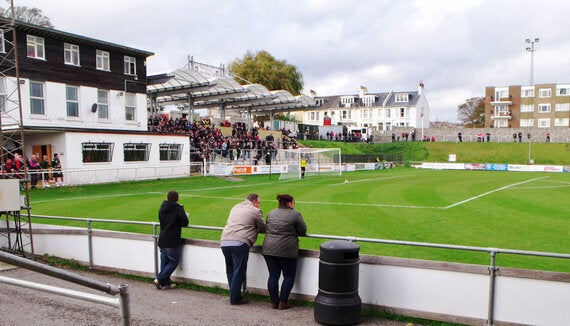
(Source: grassrootsgroundswell, Flickr)
Year opened: 1885
Capacity: 3,000
Tenants: Lewes
Fan-owned non-league Lewes FC have played at the Dripping Pan for 130 years, and although the ground has almost been completely rebuilt in recent years, it retains a unique character, aided by local residents' passion for the club and the fact the ground is built into the side of a hill. Though relatively tiny, there is a club house where guests can enjoy pints of real ale delivered directly to the ground by horse-and-cart from the local Harveys Brewery. The Dripping Pan offers a dose of authentic non-league fare, complete with cones of chips and polystyrene cups of Bovril.
10) Stade Vélodrome, France

(Source: Vladimir Varfolomeev, Flickr)
Year opened: 1937
Capacity: 67,344
Tenants: Marseille
Stade Vélodrome was built to serve as a playing venue for the 1938 World Cup, and has been home to Marseille since it opened in 1937. The stadium initially had cycling and running tracks circling the pitch, though these have since been eaten away by the extension of the stands. The stadium's capacity was recently increased to 67,344 ahead of Euro 2016, with vast improvements to its previously open roof. This renovation has ensured that an already passionate arena now roars even louder than before.
